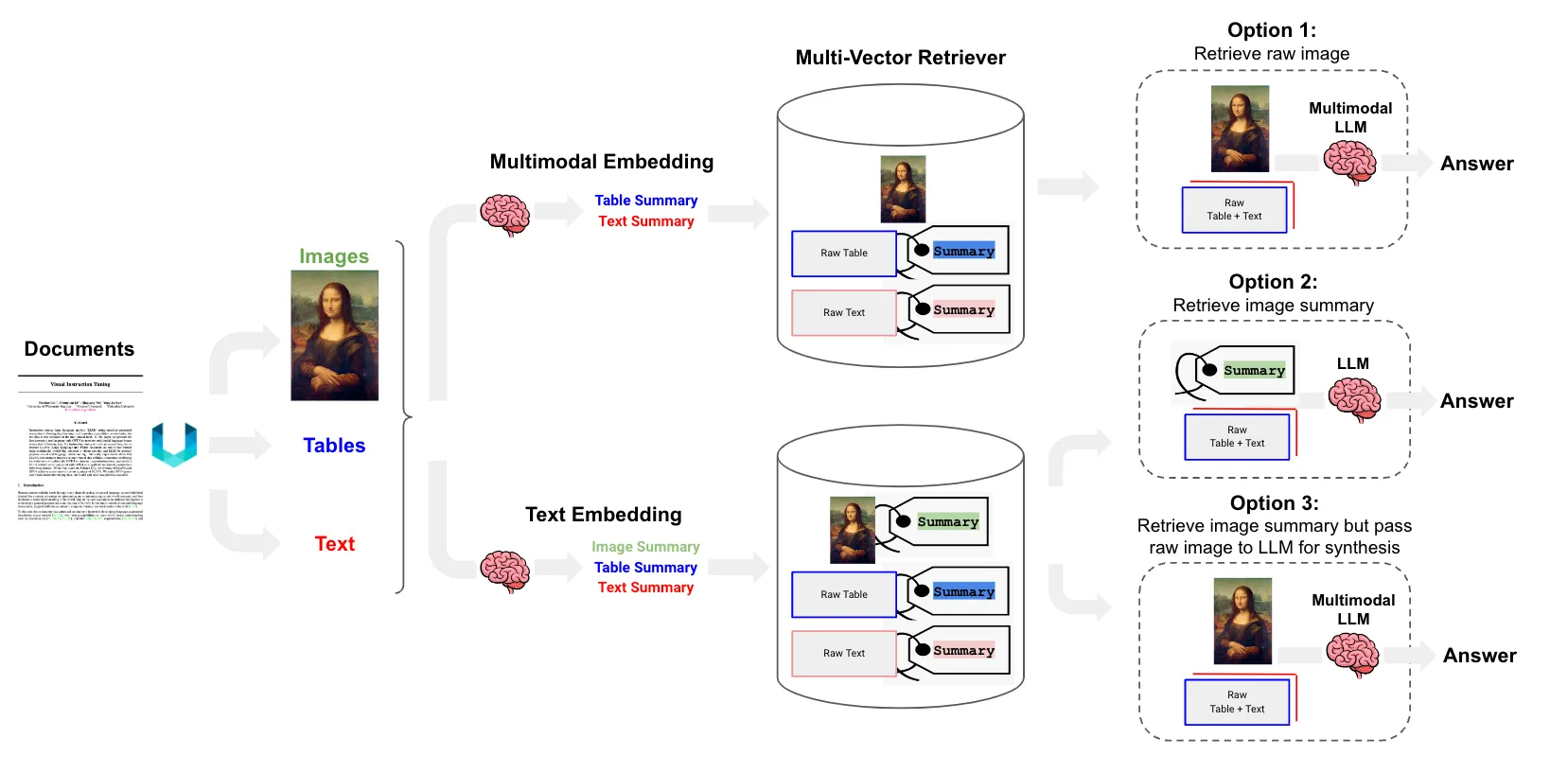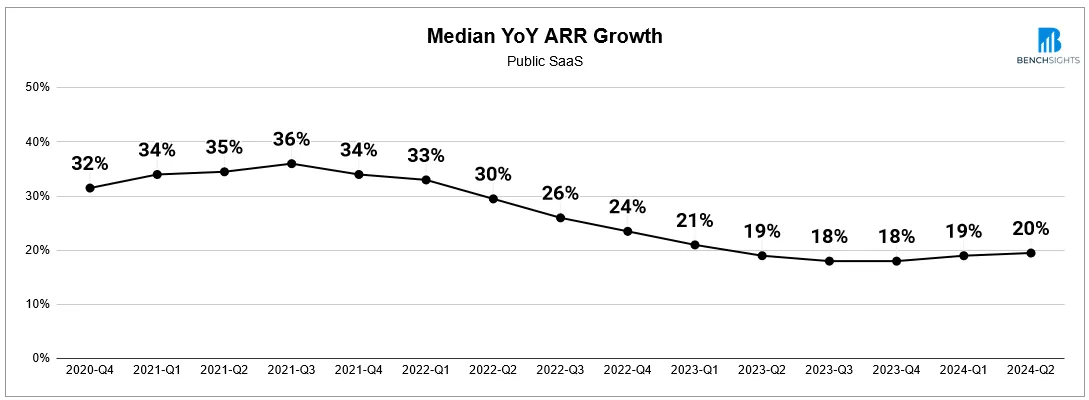【指南】多模态RAG
什么是多模态 RAG?
多模态 RAG 是一种先进的信息检索和生成方法,它结合了多种内容类型(主要是文本和图像)的优势。与只关注文本的传统 RAG 系统不同,MultiModal RAG 可同时利用文本和视觉信息的力量,为生成回复提供更全面、上下文更丰富的基础。
在我们这个日益视觉化的世界里,多模态 RAG 的重要性怎么强调都不为过。从研究论文到商业报告,许多文档都包含文本、图像、图表和表格的混合体。通过在检索和生成过程中加入视觉元素,多模态 RAG 系统就能提供更多的信息、
多模态 RAG 系统可以:
1. 捕捉纯文本分析中丢失的细微差别
2. 提供更准确、更贴近上下文的回复
3. 通过直观教具加深对复杂概念的理解 4.
4. 提高生成内容的整体质量和深度
实施多模态 RAG 的策略
开发多模态 RAG 管道有几种方法,每种方法都有自己的优势和注意事项:
联合嵌入和检索
- 利用 CLIP(对比语言-图像预训练)或 ALIGN(大规模 ImaGe 和噪声-文本嵌入)等模型为文本和图像创建统一的嵌入。
- 使用 FAISS 或 Annoy 等库实现近似近邻搜索,以提高检索效率。
- 将检索到的多模态内容(原始图像和文本块)反馈给多模态 LLM,如 LLaVa、Pixtral 12B、GPT-4V、Qwen-VL,以生成答案。
图像到文本的转换
- 使用 LLaVA 或 FUYU-8b 等模型从图像生成摘要。
- 使用基于文本的嵌入模型(如 Sentence-BERT)为原始文本和图像标题创建嵌入。
- 将文本块传递给 LLM 进行最终答案合成。
原始图像访问混合检索
- 采用多模态 LLM 从图像中生成文本摘要。
- 将这些摘要与原始图像以及其他文本块一起嵌入和检索。这可以通过多矢量检索器(Multi-Vector Retriever)和矢量数据库(如 Chroma、Milvus)来实现,以存储原始文本和图像及其摘要以供检索。
- 对于最终答案的生成,可使用 Pixtral 12B、LLaVa、GPT-4V、Qwen-VL 等多模态模型,这些模型可同时处理文本和原始图像输入。

实际实施
在本文中,我们将探讨第三种方法,即利用尖端工具的强大组合来创建一个高效、有效的多模态 RAG 系统:
- 非结构化: 用于解析各种文档格式(包括 PDF)中的图像、文本和表格。
- 通过 vLLM 的 LLaVa:在 vLLM 服务引擎的支持下,该设置使用名为 LLaVA(llava-hf/llava-1.5-7b-hf)的视觉语言模型(VLM)来处理文本/表格摘要和多模态任务,如图像摘要和从综合文本和视觉输入生成答案。虽然 LLaVA 并不是最先进的模型,但它效率高、计算成本低。得益于 vLLM,它可以无缝地部署在 CPU 上,对于那些希望在性能和资源效率之间取得平衡的人来说,这是一个理想的、经济高效的解决方案。
- Chroma DB:作为我们的矢量数据库,可存储文本块、表格摘要和图像摘要以及原始图像。它与多矢量检索器(MultiVector Retriever)功能相结合,为我们的多模态系统提供了一个强大的存储和检索系统。
- LangChain: 作为无缝集成这些组件的协调工具。
通过结合这些工具,我们将演示如何构建一个强大的多模态 RAG 系统,该系统可以处理各种类型的文档,生成高质量的摘要,并利用文本和视觉信息生成全面的答案。
下载数据
我们将使用这篇博文作为我们的文档源,因为其中包含通过图片形式的图表呈现的宝贵信息。
import os
import io
import re
import uuid
import base64
import shutil
import requests
from tqdm import tqdm
from PIL import Image
import matplotlib.pyplot as plt
from IPython.display import HTML, display
from unstructured.partition.pdf import partition_pdf
from langchain_core.documents import Document
from langchain_text_splitters import CharacterTextSplitter
from langchain.storage import InMemoryStore
from langchain_chroma import Chroma
from langchain.chains.llm import LLMChain, PromptTemplate
from langchain_core.messages import HumanMessage, SystemMessage
from langchain_core.prompts.chat import (ChatPromptTemplate, HumanMessagePromptTemplate, SystemMessagePromptTemplate)
from langchain_core.output_parsers import StrOutputParser
from langchain_core.runnables import RunnableLambda, RunnablePassthrough
from langchain.retrievers.multi_vector import MultiVectorRetriever
from openai import OpenAI as OpenAI_vLLM
from langchain_community.llms.vllm import VLLMOpenAI
from langchain.embeddings import HuggingFaceEmbeddings
embeddings = HuggingFaceEmbeddings(model_name='BAAI/bge-large-en')
os.mkdir("data")"data")
shutil.move("gtm_benchmarks_2024.pdf", "data")从 PDF 文档中提取文本、表格和图片
下载 PDF 文档后,我们将利用 unstructured.io 库处理文档并提取内容。
# Extract elements from PDF
def extract_pdf_elements(path, fname):
"""
Extract images, tables, and chunk text from a PDF file.
path: File path, which is used to dump images (.jpg)
fname: File name
"""
return partition_pdf(
filename=path + fname,
extract_images_in_pdf=True,
infer_table_structure=True,
chunking_strategy="by_title",
max_characters=4000,
new_after_n_chars=3800,
combine_text_under_n_chars=2000,
image_output_dir_path=path,
)
# Categorize elements by type
def categorize_elements(raw_pdf_elements):
"""
Categorize extracted elements from a PDF into tables and texts.
raw_pdf_elements: List of unstructured.documents.elements
"""
tables = []
texts = []
for element in raw_pdf_elements:
if "unstructured.documents.elements.Table" in str(type(element)):
tables.append(str(element))
elif "unstructured.documents.elements.CompositeElement" in str(type(element)):
texts.append(str(element))
return texts, tables
# File path
folder_path = "./data/"
file_name = "gtm_benchmarks_2024.pdf"
# Get elements
raw_pdf_elements = extract_pdf_elements(folder_path, file_name)
# Get text, tables
texts, tables = categorize_elements(raw_pdf_elements)
# Enforce a specific token size for texts
text_splitter = CharacterTextSplitter.from_tiktoken_encoder(
chunk_size = 1000, chunk_overlap = 0
)
joined_texts = " ".join(texts)
texts_token = text_splitter.split_text(joined_texts)
print("No of Textual Chunks:", len(texts))
print("No of Table Elements:", len(tables))
print("No of Text Chunks after Tokenization:", len(texts_token))
生成表格摘要
我们将使用运行在 CPU 机器上的 vLLM 引擎为 7B 参数的 LLaVA 模型(llava-hf/llava-1.5-7b-hf)提供服务,以生成表格摘要。我们也可以使用基于文本的 LLM,正如我们在任何 RAG 系统中通常所做的那样,但现在,我们将使用 LLaVa 模型本身,它可以处理文本和图像。
我们生成表格摘要,以加强自然语言检索。这些摘要对于高效检索原始表格和文本块至关重要。
# Initialize vLLM API server
llm_client = VLLMOpenAI(
base_url = "http://localhost:8000/v1",
api_key = "dummy",
model_name = "llava-hf/llava-1.5-7b-hf",
temperature = 1.0,
max_tokens = 300
)
# Generate summaries of table elements
def generate_text_summaries(texts, tables, summarize_texts=False):
"""
Summarize text elements
texts: List of str
tables: List of str
summarize_texts: Bool to summarize texts
"""
# Prompt
prompt_text = """You are an assistant tasked with summarizing tables for retrieval. \
Give a concise summary of the table that is well optimized for retrieval. Make sure to capture all the details. \
Input: {element} """
prompt = ChatPromptTemplate.from_template(prompt_text)
# Text summary chain
summarize_chain = {"element": lambda x: x} | prompt | llm_client | StrOutputParser()
# Initialize empty summaries
text_summaries = []
table_summaries = []
# Apply to text if texts are provided and summarization is requested
if texts and summarize_texts:
text_summaries = summarize_chain.batch(texts, {"max_concurrency": 3})
elif texts:
text_summaries = texts
# Apply to tables if tables are provided
if tables:
table_summaries = summarize_chain.batch(tables, {"max_concurrency": 3})
return text_summaries, table_summaries
# Get text, table summaries
text_summaries, table_summaries = generate_text_summaries(
texts_4k_token, tables, summarize_texts=False
)
print("No of Text Summaries:", len(text_summaries))
print("No of Table Summaries:", len(table_summaries))
生成图像摘要
现在,我们将利用视觉语言模型(VLM)来生成图像摘要。
注:图像可以通过两种主要方式提供给模型:传递图像链接或在请求中直接传递 base64 编码图像。
# vLLM OpenAI-compatible API client
api_key = "dummy"
base_url = "http://localhost:8000/v1"
vlm_client = OpenAI_vLLM(
api_key = api_key,
base_url = base_url,
)
def encode_image(image_path):
"""Getting the base64 string"""
with open(image_path, "rb") as image_file:
return base64.b64encode(image_file.read()).decode("utf-8")
def image_summarize(img_base64, prompt):
"""Make image summary"""
chat_response = vlm_client.chat.completions.create(
model="llava-hf/llava-1.5-7b-hf",
max_tokens=1024,
messages=[{
"role": "user",
"content": [
{"type": "text", "text": prompt},
{
"type": "image_url",
"image_url": {
"url": f__"data:image/jpeg;base64,{img_base64}",
},
},
],
}],
stream=False
)
return chat_response.choices[0].message.content.strip()
def generate_img_summaries(path):
"""
Generate summaries and base64 encoded strings for images
path: Path to list of .jpg files extracted by Unstructured
"""
# Store base64 encoded images
img_base64_list = []
# Store image summaries
image_summaries = []
# Prompt
prompt = """You are an assistant tasked with summarizing images for optimal retrieval. \
These summaries will be embedded and used to retrieve the raw image.
Write a clear and concise summary that captures all the important information, including any statistics or key points present in the image."""
# Apply to images
for img_file in tqdm(sorted(os.listdir(path))):
if img_file.endswith(".jpg"):
img_path = os.path.join(path, img_file)
base64_image = encode_image(img_path)
img_base64_list.append(base64_image)
# image_summaries.append(image_summarize(base64_image, prompt))
generated_summary = image_summarize(base64_image, prompt)
print(generated_summary)
image_summaries.append(generated_summary)
return img_base64_list, image_summaries
# Image summaries
img_base64_list, image_summaries = generate_img_summaries(folder_path)
assert len(img_base64_list) == len(image_summaries)
存储文档摘要并编制索引
为了配置多矢量检索器,我们将在文档库中存储原始文档(包括文本、表格和图片),同时在矢量库中为文档摘要编制索引,以提高语义检索效率。
def create_multi_vector_retriever(
vectorstore, text_summaries, texts, table_summaries, tables, image_summaries, images
):
"""
Create retriever that indexes summaries, but returns raw images or texts
"""
# Initialize the storage layer
store = InMemoryStore()
id_key = "doc_id"
# Create the multi-vector retriever
retriever = MultiVectorRetriever(
vectorstore=vectorstore,
docstore=store,
id_key=id_key,
)
# Helper function to add documents to the vectorstore and docstore
def add_documents(retriever, doc_summaries, doc_contents):
doc_ids = [str(uuid.uuid4()) for _ in doc_contents]
summary_docs = [
Document(page_content=s, metadata={id_key: doc_ids[i]})
for i, s in enumerate(doc_summaries)
]
retriever.vectorstore.add_documents(summary_docs)
retriever.docstore.mset(list(zip(doc_ids, doc_contents)))
# Add texts, tables, and images
# Check that text_summaries is not empty before adding
if text_summaries:
add_documents(retriever, text_summaries, texts)
# Check that table_summaries is not empty before adding
if table_summaries:
add_documents(retriever, table_summaries, tables)
# Check that image_summaries is not empty before adding
if image_summaries:
add_documents(retriever, image_summaries, images)
return retriever
# The vectorstore to use to index the summaries
vectorstore = Chroma(
collection_name="mm_rag_vectorstore", embedding_function=embeddings, persist_directory="./chroma_db"
)
# Create retriever
retriever_multi_vector_img = create_multi_vector_retriever(
vectorstore,
text_summaries,
texts,
table_summaries,
tables,
image_summaries,
img_base64_list,
)
多矢量检索设置
接下来,我们定义了用于处理文本数据和 base64 编码图像的函数和配置,包括调整图像大小和格式化模型提示。它建立了一个多模式检索和生成(RAG)上下文链,以整合和分析文本和图像数据,从而回答用户的查询。
由于我们使用 vLLM 的 HTTP 服务器为我们的视觉语言模型提供服务,该服务器与 OpenAI 视觉 API(聊天完成 API)兼容,因此要为模型设置上下文,我们需要遵循此处提供的特定聊天模板。
def plt_img_base64(img_base64):
"""Disply base64 encoded string as image"""
# Create an HTML img tag with the base64 string as the source
image_html = f'<img src=__"data:image/jpeg;base64,{img_base64}" />'
# Display the image by rendering the HTML
display(HTML(image_html))
def looks_like_base64(sb):
"""Check if the string looks like base64"""
return re.match("^[A-Za-z0-9+/]+[=]{0,2}$", sb) is not None
def is_image_data(b64data):
"""
Check if the base64 data is an image by looking at the start of the data
"""
image_signatures = {
b"\xff\xd8\xff": "jpg",
b"\x89\x50\x4e\x47\x0d\x0a\x1a\x0a": "png",
b"\x47\x49\x46\x38": "gif",
b"\x52\x49\x46\x46": "webp",
}
try:
header = base64.b64decode(b64data)[:8] # Decode and get the first 8 bytes
for sig, format in image_signatures.items():
if header.startswith(sig):
return True
return False
except Exception:
return False
def resize_base64_image(base64_string, size=(64, 64)):
"""
Resize an image encoded as a Base64 string
"""
# Decode the Base64 string
img_data = base64.b64decode(base64_string)
img = Image.open(io.BytesIO(img_data))
# Resize the image
resized_img = img.resize(size, Image.LANCZOS)
# Save the resized image to a bytes buffer
buffered = io.BytesIO()
resized_img.save(buffered, format=img.format)
# Encode the resized image to Base64
return base64.b64encode(buffered.getvalue()).decode("utf-8")
def split_image_text_types(docs):
"""
Split base64-encoded images and texts
"""
b64_images = []
texts = []
for doc in docs:
# Check if the document is of type Document and extract page_content if so
if isinstance(doc, Document):
doc = doc.page_content
if looks_like_base64(doc) and is_image_data(doc):
doc = resize_base64_image(doc, size=(64, 64))
b64_images.append(doc)
else:
texts.append(doc)
return {"images": b64_images, "texts": texts}
def img_prompt_func(data_dict):
"""
Join the context into a single string
"""
formatted_texts = "\n".join(data_dict["context"]["texts"])
messages = []
# Adding the text for analysis
text_message = {
"type": "text",
"text": (
"You are an AI assistant with expertise in finance and business metrics.\n"
"You will be given information that may include text, tables, and charts related to business performance and industry trends.\n"
"Your task is to analyze this information and provide a clear, concise answer to the user's question.\n"
"Focus on the most relevant data points and insights that directly address the user's query.\n"
f"User's question: {data_dict['question']}\n\n"
"Information provided:\n"
f"{formatted_texts}"
),
}
messages.append(text_message)
# Adding image(s) to the messages if present
if data_dict["context"]["images"]:
for image in data_dict["context"]["images"]:
image_message = {
"type": "image_url",
"image_url": {"url": f__"data:image/jpeg;base64,{image}"},
}
messages.append(image_message)
return [HumanMessage(content=messages)]
def multi_modal_rag_context_chain(retriever):
"""Multi-modal RAG context chain"""
chain = (
{
"context": retriever | RunnableLambda(split_image_text_types),
"question": RunnablePassthrough(),
}
| RunnableLambda(img_prompt_func)
)
return chain
# Retrieve the relevant context including text and images
chain_multimodal_context = multi_modal_rag_context_chain(retriever_multi_vector_img)
检查检索
# Check retrieval
query = "How has the median YoY ARR growth rate for public SaaS companies changed from 2020 to 2024?"
docs = retriever_multi_vector_img.invoke(query)
# We get back relevant images
plt_img_base64(docs[0])

运行 RAG 管道生成答案
由于我们当前的模型不支持超长上下文和每个文本提示多个多模态项目,因此我们将修改检索到的上下文,并测试最终的答案合成部分。
context = chain_multimodal_context.invoke(query)[0].content0].content
context = [
{
'type': 'text','type': 'text',
'text': "You are an AI assistant with expertise in finance and business metrics.\nYou will be given information that may include text, tables, and charts related to business performance and industry trends.\nYour task is to analyze this information and provide a clear, concise answer to the user's question.\nFocus on the most relevant data points and insights that directly address the user's query.\nUser's question: How has the median YoY ARR growth rate for public SaaS companies changed from 2020 to 2024?"
},
{
'type': 'image_url',
'image_url': {'url': __'data:image/jpeg;base64,/9j/4AAQSkZJRgABAQAAAQABAAD/2wBDAAgGBgcGBQgHBwcJCQgKDBQNDAsLDBkSEw8UHRofHh0aHBwgJC4nICIsIxwcKDcpLDAxNDQ0Hyc5PTgyPC4zNDL/2wBDAQkJCQwLDBgNDRgyIRwhMjIyMjIyMjIyMjIyMjIyMjIyMjIyMjIyMjIyMjIyMjIyMjIyMjIyMjIyMjIyMjIyMjL/wAARCABAAEADASIAAhEBAxEB/8QAHwAAAQUBAQEBAQEAAAAAAAAAAAECAwQFBgcICQoL/8QAtRAAAgEDAwIEAwUFBAQAAAF9AQIDAAQRBRIhMUEGE1FhByJxFDKBkaEII0KxwRVS0fAkM2JyggkKFhcYGRolJicoKSo0NTY3ODk6Q0RFRkdISUpTVFVWV1hZWmNkZWZnaGlqc3R1dnd4eXqDhIWGh4iJipKTlJWWl5iZmqKjpKWmp6ipqrKztLW2t7i5usLDxMXGx8jJytLT1NXW19jZ2uHi4+Tl5ufo6erx8vP09fb3+Pn6/8QAHwEAAwEBAQEBAQEBAQAAAAAAAAECAwQFBgcICQoL/8QAtREAAgECBAQDBAcFBAQAAQJ3AAECAxEEBSExBhJBUQdhcRMiMoEIFEKRobHBCSMzUvAVYnLRChYkNOEl8RcYGRomJygpKjU2Nzg5OkNERUZHSElKU1RVVldYWVpjZGVmZ2hpanN0dXZ3eHl6goOEhYaHiImKkpOUlZaXmJmaoqOkpaanqKmqsrO0tba3uLm6wsPExcbHyMnK0tPU1dbX2Nna4uPk5ebn6Onq8vP09fb3+Pn6/9oADAMBAAIRAxEAPwD3wRoQOP1o8pPT9abFKX3Axuu1toJH3vce1SbvY0AN8pPT9axf7Zn+0zQDQr/MblRIQAjjdjcDnp0P0zW5u9jUVxCtxCY2MqAkHdG20j8RQBiW2uXM0sUcvh7UIfMkCbiAVQZI3Me3Az3re8pPT9aZbwi2iEatK4BJzI248+9S7vY0AN8pPT9arXcy20lqnlFvPl8rO7G35Sc+/TH41b3exqKWJJWV2D5UHGGIH5U1bqJ3toLHMj7gA3yNtOVI5x29arpq9hI1uqXSObgssW3kOV+8AfaoLxhLc2ssDXDyQSMhjiYKmSv/AC0J7fnyaZDY3SpEPNsLZUZjtt7fkA/3STgHpk45pDLFpq1tdRW7MHt5JywjhnXa7bevH61cWVHUMjBlPQryDWYbG5hlhZJ4bsRlvmu1/eLn+66jj8qr2TPZzWdnElvZRIJDLbM5cv3Bjbv6n69KAN3cPf8AI0bh7/karWWoW2oWkdzA+Y5ASu4bTwcdDVncv94UAG4e/wCRpCwIPXp6Uu5fUUhYEHkdKAESRGBCupKna2D0PoadkeopqKgBKquSctgd/enYHoKADI9RUU8ENygWVQcHKnOCp9QexqXA9BRgegoAxZLWeG6tp50N60CuqXKHa8efVBw31Hp0qXT724lhtPKkiv4WV/OuVYKVPVRt/TtWrgegqtPp1pczpPLCDMgIWRSVYA+457UAV4NTnn+yg6dcRmeN2bfj90R0DfXtSQXGpyS2wntYIY3iYzjzdzI+eAvqP8aeukQARhpryRUUrh7lyD06889Kkt9MsbIA21pDEyIUDKg3BeOM9ew/KgCxHDGm4qigudzEDqfWn7V9BVKS33TJJFcCNScyLyd/AHrx0pi2so8vdfBsZ3/Ljd+vFAGhtX0FG1fQVnrayjZuvw2M7vlxu/XihbWYeXuvw20Hf8uN3p34oA0Nq+go2r6Cs9bWYbN1+DgHd8v3vTvxQtrMNmb8HCkN8uNx7HrxjigDQ2r6CkKgA8DpVAWsw2ZvwcKQ3y9Tzg9eMcflTo7eVHjZr0OFB3rtxuPPPXjt+VAH/9k='}
}
]
chat_response = vlm_client.chat.completions.create(
model="llava-hf/llava-1.5-7b-hf","llava-hf/llava-1.5-7b-hf",
messages=[{
"role": "user",
"content": context,
}],
stream=True
)
for chunk in chat_response:
if chunk.choices[0].delta.content:
print(chunk.choices[0].delta.content, end="", flush=True)
根据用户提供的问题以及检索到的文本片段和图片,模型将开始流式传输其响应。
结论
总之,多模态 RAG 系统代表了信息检索和处理领域的一大进步。这项技术为各行各业(从医疗保健和金融到教育和自主系统)增强决策过程打开了大门。































